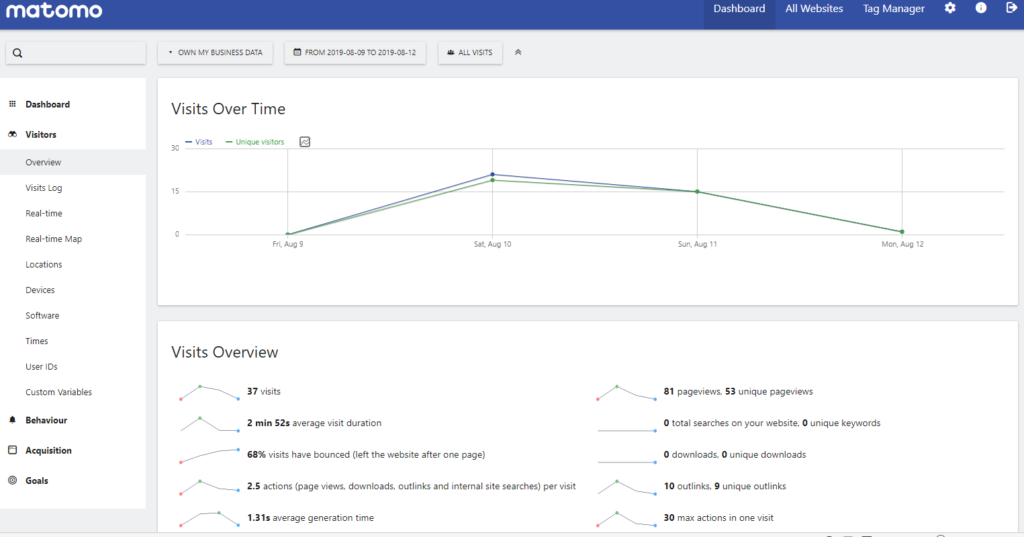Suppose you like “own your business data” concept, but how does it work in practice? What are the tools that can be used and importantly don’t make your CFO (if you have one) cry?
Let’s start with the most popular one – tool for web analytics.
Almost any business has at least one website and web analytics allows to track visitors activity there:
- Where people coming from (channels, referral, marketing campaigns)
- Who they are (identity, location)
- What they do on the website (pageviews, time on the website, conversions)
Google Analytics is the most popular web analytic solution. It has free version used by the most small and medium businesses and a quite expensive paid version Analytics 360 with price tag over $150,000 per year.
What may be wrong with Google Analytics free version? While it is a solid tool, there are number of drawbacks:
- The reports you see in Google Analytics free version may be sampled: it means that at some level (500K sessions at the moment) for the range selected you start to see reports based not the all but with randomly sampled portion of your data. So you see reports based on say 20% of your actual sessions. Making business decision based on sampled data can be quite dangerous. Data sampling is an interesting topic, you may check this blog post on OptimizeSmart for more in-depth understanding. 500K seems to be a big threshold, but if you do basic calculation it comes to 1,370 sessions per day in annual reports.
- You have limits of what data you can pull from Google Analytics. It has API, but that API has limits, so if you suddenly decide that you need to pull significant data from there and use it with other systems – there is a high chance that it will be impossible to do
- You share your data with Google with all positive and negative consequences
That limitation are softened in Analytics 360, but in this case you need to prepare $150K per year.
Luckily there are alternatives to Google Analytics and some of that alternatives allows you really control the data collected from your business websites.
Matomo
Matomo (recently changed its name from Piwik) is an open source web analytic solution. It is pretty much like your own Google Analytics, which you can host on your own server and have full control over the data collected.
Matomo is plug&play solution that can be set-up and configured very quickly. For popular content management systems like WordPress it even has plug-ins that makes configuration even quicker. But even if there is no plugin, the configuration very similar with what you do with Google Analytics: you install Matomo tags (pieces of Javascript code) to your website pages and tracking starts to work.
You may host Matomo on simple LAMP (Linux/Apache/PHP/MySQL) hosting, initial installation and configuration can be done by semi-decent IT person under 1-2 hrs time. Of cause you need to invest more time if you want to do more complex set up, but default configuration is a very solid replacement of free Google Analytics. Matomo isn’t very resource hungry and just works.
We use Matomo on this website, here is how one of the reports looks

So it is really to go solution for small businesses that prefer to own its business data, but have limited resources to use more sophisticated approach.
Snowplow Analytics
If you want to uplift your data game and start to collect the data into proper data warehouse the solution to consider is Snowplow Analytics. It is enterprise-strength solution, has hosted/SaaS and open-source deployment options.
Snowplow isn’t all-in-one plug&play solution like Matomo and it requires more serious investments to set up. Once set, the data from various sources including your websites will be stored in flat files with AWS S3 or in the database (Redshift or Postgres).
To analyse the data collected, build reports and dashboards you can plug to your data warehouse almost any decent business intelligence tool: Tableau, MS BI, Mode Analytics, Redish.io to name few.
Moreover, you can start truly leverage the data collected by connecting your warehouse with programming languages used for data science – Python and R.
Snowplow can even work alongside Google Analytics, so you can continue using Google Analytics and at the same time collect the data into your own data warehouse.
What is great about Snowplow is that using it isn’t necessary very expensive to run, just recently we have managed to set it up using AWS Lambda for expected ongoing costs budget under $1/month.
Wrap-up/Conclusion
There are Google Analytics alternatives that allow a business to really own its data. Moreover to set and run them isn’t necessary extremely hard and expensive. Matomo is plug and play tool that even small business can use; Snowplow is more complex and powerful, but still can be set up to run in quiet affordable way.

There are more options than the two listed.
Check out Angelfish Software